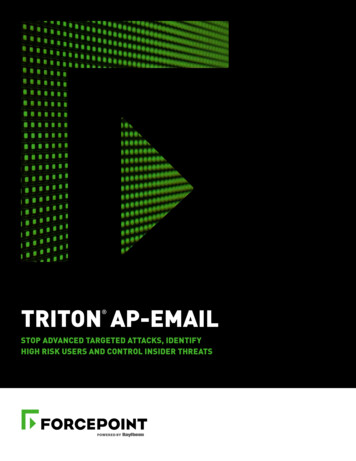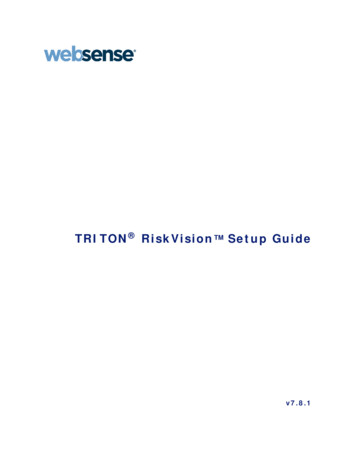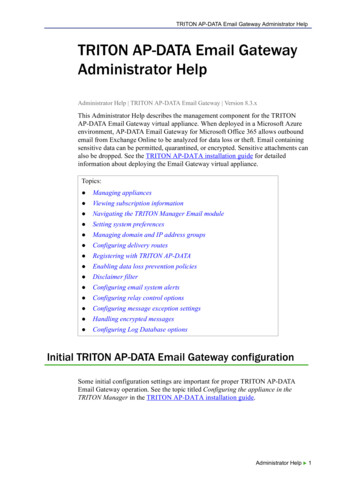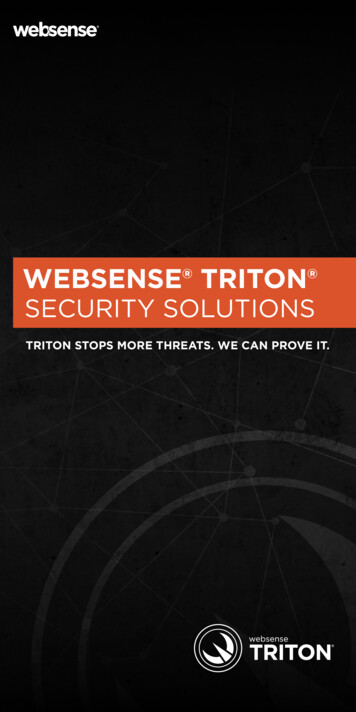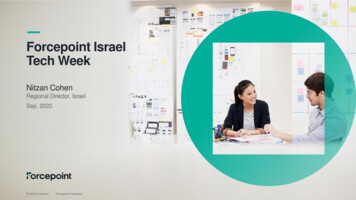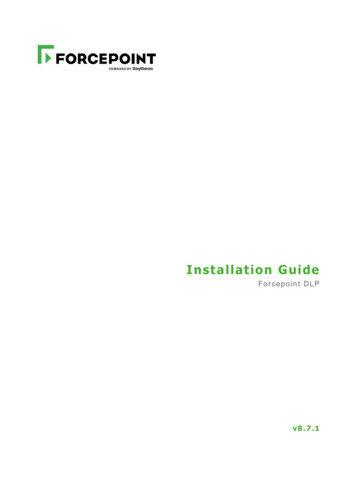
Transcription
Forcepoint AppliancesGetting Started GuideV Series, X Series, & Virtual Appliancesv8 .4 .x
1996–2017, Forcepoint LLC10900-A Stonelake Blvd, Quarry Oaks 1, Suite 350, Austin, TX 78759, USAAll rights reserved.Published 2018Printed in the United States and IrelandD230317840The products and/or methods of use described in this document are covered by U.S. Patent Numbers 5,983,270; 6,606,659; 6,947,985; 7,185,015;7,194,464 and RE40,187 and other patents pending.This document may not, in whole or in part, be copied, photocopied, reproduced, translated, or reduced to any electronic medium or machinereadable form without prior consent in writing from Forcepoint LLC.Every effort has been made to ensure the accuracy of this manual. However, Forcepoint LLC, makes no warranties with respect to thisdocumentation and disclaims any implied warranties of merchantability and fitness for a particular purpose. Forcepoint LLC shall not be liable forany error or for incidental or consequential damages in connection with the furnishing, performance, or use of this manual or the examples herein.The information in this documentation is subject to change without notice.TrademarksForcepoint is a registered trademark and TRITON is a trademark of Forcepoint LLC, in the United States and certain international markets.Forcepoint has numerous other unregistered trademarks in the United States and internationally. All other trademarks are the property of theirrespective owners.Microsoft, Windows, Windows NT, Windows Server, and Active Directory are either registered trademarks or trademarks of MicrosoftCorporation in the United States and/or other countries.Oracle and Java are registered trademarks of Oracle and/or its affiliates. Other names may be trademarks of their respective owners.Mozilla and Firefox are registered trademarks of the Mozilla Foundation in the United States and/or other countries.eDirectory and Novell Directory Services are a registered trademarks of Novell, Inc., in the U.S and other countries.Adobe, Acrobat, and Acrobat Reader are either registered trademarks or trademarks of Adobe Systems Incorporated in the United States and/orother countries.Red Hat is a registered trademark of Red Hat, Inc., in the United States and other countries. Linux is a trademark of Linus Torvalds, in the UnitedStates and other countries.This product includes software distributed by the Apache Software Foundation (http://www.apache.org).Copyright (c) 2000. The Apache Software Foundation. All rights reserved.Other product names mentioned in this manual may be trademarks or registered trademarks of their respective companies and are the sole propertyof their respective manufacturers.
ContentsTopic 1Forcepoint Appliances . . . . . . . . . . . . . . . . . . . . . . . . . . . . . . . . . . . . . . . . . . . . . 1Supported software. . . . . . . . . . . . . . . . . . . . . . . . . . . . . . . . . . . . . . . . . . . . . . . . . 2Forcepoint Email Security. . . . . . . . . . . . . . . . . . . . . . . . . . . . . . . . . . . . . . . . . 2Forcepoint Web Security. . . . . . . . . . . . . . . . . . . . . . . . . . . . . . . . . . . . . . . . . . 2Forcepoint URL Filtering . . . . . . . . . . . . . . . . . . . . . . . . . . . . . . . . . . . . . . . . . 2Forcepoint DLP . . . . . . . . . . . . . . . . . . . . . . . . . . . . . . . . . . . . . . . . . . . . . . . . . 3Appliance platforms . . . . . . . . . . . . . . . . . . . . . . . . . . . . . . . . . . . . . . . . . . . . . . . . 4V Series . . . . . . . . . . . . . . . . . . . . . . . . . . . . . . . . . . . . . . . . . . . . . . . . . . . . . . . 4X Series . . . . . . . . . . . . . . . . . . . . . . . . . . . . . . . . . . . . . . . . . . . . . . . . . . . . . . . 4Forcepoint Virtual Appliances . . . . . . . . . . . . . . . . . . . . . . . . . . . . . . . . . . . . . 5Features. . . . . . . . . . . . . . . . . . . . . . . . . . . . . . . . . . . . . . . . . . . . . . . . . . . . . . . . . . 6Platform hardening . . . . . . . . . . . . . . . . . . . . . . . . . . . . . . . . . . . . . . . . . . . . . . 6Command-line interface . . . . . . . . . . . . . . . . . . . . . . . . . . . . . . . . . . . . . . . . . . 6Forcepoint Security Appliance Manager. . . . . . . . . . . . . . . . . . . . . . . . . . . . . . 7Custom appliance user account management . . . . . . . . . . . . . . . . . . . . . . . . . . 7Forcepoint appliance platform API . . . . . . . . . . . . . . . . . . . . . . . . . . . . . . . . . . 7Stacking module on X10G . . . . . . . . . . . . . . . . . . . . . . . . . . . . . . . . . . . . . . . . 710GBe PCI NIC on V10K. . . . . . . . . . . . . . . . . . . . . . . . . . . . . . . . . . . . . . . . . 7Deployment . . . . . . . . . . . . . . . . . . . . . . . . . . . . . . . . . . . . . . . . . . . . . . . . . . . . . . 8Configuration and management . . . . . . . . . . . . . . . . . . . . . . . . . . . . . . . . . . . . . . . 8Documentation . . . . . . . . . . . . . . . . . . . . . . . . . . . . . . . . . . . . . . . . . . . . . . . . . . . . 8Topic 2Deploying Forcepoint Appliances . . . . . . . . . . . . . . . . . . . . . . . . . . . . . . . . . . . 11Deployment planning . . . . . . . . . . . . . . . . . . . . . . . . . . . . . . . . . . . . . . . . . . . . . . 11Deployment big picture . . . . . . . . . . . . . . . . . . . . . . . . . . . . . . . . . . . . . . . . . . . . 13Required off-appliance components . . . . . . . . . . . . . . . . . . . . . . . . . . . . . . . . 14Web protection deployments. . . . . . . . . . . . . . . . . . . . . . . . . . . . . . . . . . . . . . 15Forcepoint Email Security deployments . . . . . . . . . . . . . . . . . . . . . . . . . . . . . 20Deployment activity summary . . . . . . . . . . . . . . . . . . . . . . . . . . . . . . . . . . . . . . . 21Forcepoint appliance installation summary . . . . . . . . . . . . . . . . . . . . . . . . . . . . . 21Topic 3V Series Hardware Setup. . . . . . . . . . . . . . . . . . . . . . . . . . . . . . . . . . . . . . . . . . 23V10000 hardware setup . . . . . . . . . . . . . . . . . . . . . . . . . . . . . . . . . . . . . . . . . . . . 24V10000 with Forcepoint Web Security. . . . . . . . . . . . . . . . . . . . . . . . . . . . . . 24V10000 with Forcepoint Email Security. . . . . . . . . . . . . . . . . . . . . . . . . . . . . 24V5000 hardware setup . . . . . . . . . . . . . . . . . . . . . . . . . . . . . . . . . . . . . . . . . . . . . 25Using the iDRAC . . . . . . . . . . . . . . . . . . . . . . . . . . . . . . . . . . . . . . . . . . . . . . . . . 26Getting Started i
ContentsConnecting directly to the appliance . . . . . . . . . . . . . . . . . . . . . . . . . . . . . . . . . . 27Topic 4X Series Hardware Setup. . . . . . . . . . . . . . . . . . . . . . . . . . . . . . . . . . . . . . . . . . 29X10G hardware setup . . . . . . . . . . . . . . . . . . . . . . . . . . . . . . . . . . . . . . . . . . . . . . 29Receiving and racking the hardware . . . . . . . . . . . . . . . . . . . . . . . . . . . . . . . . . . 30Unloading at your shipping dock . . . . . . . . . . . . . . . . . . . . . . . . . . . . . . . . . . 30X10G Quick Start poster . . . . . . . . . . . . . . . . . . . . . . . . . . . . . . . . . . . . . . . . . . . 31Security blade slots. . . . . . . . . . . . . . . . . . . . . . . . . . . . . . . . . . . . . . . . . . . . . . . . 31iDRAC and interface IP address planning . . . . . . . . . . . . . . . . . . . . . . . . . . . 32X10G chassis cabling . . . . . . . . . . . . . . . . . . . . . . . . . . . . . . . . . . . . . . . . . . . . . . 33Power on . . . . . . . . . . . . . . . . . . . . . . . . . . . . . . . . . . . . . . . . . . . . . . . . . . . . . 35Set up the CMC IP Address . . . . . . . . . . . . . . . . . . . . . . . . . . . . . . . . . . . . . . . . . 36Assigning blade slot iDRAC addresses . . . . . . . . . . . . . . . . . . . . . . . . . . . . . . . . 37iDRAC Virtual Console . . . . . . . . . . . . . . . . . . . . . . . . . . . . . . . . . . . . . . . . . . . . 38Topic 5Forcepoint Virtual Appliance Setup . . . . . . . . . . . . . . . . . . . . . . . . . . . . . . . . . 39Creating a Forcepoint ESXi VMware virtual appliance. . . . . . . . . . . . . . . . . . . . 39Virtual appliance creation summary . . . . . . . . . . . . . . . . . . . . . . . . . . . . . . . . 39Creating the virtual machine . . . . . . . . . . . . . . . . . . . . . . . . . . . . . . . . . . . . . . 40Topic 6Firstboot Wizard . . . . . . . . . . . . . . . . . . . . . . . . . . . . . . . . . . . . . . . . . . . . . . . . 41The firstboot wizard (initial command-line configuration) . . . . . . . . . . . . . . . . . 41Gather data for firstboot . . . . . . . . . . . . . . . . . . . . . . . . . . . . . . . . . . . . . . . . . 42Run firstboot . . . . . . . . . . . . . . . . . . . . . . . . . . . . . . . . . . . . . . . . . . . . . . . . . . 44Topic 7Configure Appliances (post-firstboot) . . . . . . . . . . . . . . . . . . . . . . . . . . . . . . . 47SSH access to the CLI . . . . . . . . . . . . . . . . . . . . . . . . . . . . . . . . . . . . . . . . . . . . . 47Verify firstboot configuration settings . . . . . . . . . . . . . . . . . . . . . . . . . . . . . . . . . 48Configuration basics . . . . . . . . . . . . . . . . . . . . . . . . . . . . . . . . . . . . . . . . . . . . 48Appliance management interface (C) . . . . . . . . . . . . . . . . . . . . . . . . . . . . . . . 49System time and time synchronization with Forcepoint servers. . . . . . . . . . . 49Add an appliance description . . . . . . . . . . . . . . . . . . . . . . . . . . . . . . . . . . . . . 50Establish a filestore. . . . . . . . . . . . . . . . . . . . . . . . . . . . . . . . . . . . . . . . . . . . . . . . 51Set an email address for password recovery. . . . . . . . . . . . . . . . . . . . . . . . . . . . . 51Configure additional network interfaces . . . . . . . . . . . . . . . . . . . . . . . . . . . . . . . 52Support for IPv6 . . . . . . . . . . . . . . . . . . . . . . . . . . . . . . . . . . . . . . . . . . . . . . . 52Appliance management interface (C) . . . . . . . . . . . . . . . . . . . . . . . . . . . . . . . 53Content Gateway (web proxy) interfaces (P1 and P2) . . . . . . . . . . . . . . . . . . 53Web protection: Network Agent interface (N) . . . . . . . . . . . . . . . . . . . . . . . . 55Forcepoint Email Security interfaces (E1 and E2, or P1 and P2) . . . . . . . . . . 56Interface bonding. . . . . . . . . . . . . . . . . . . . . . . . . . . . . . . . . . . . . . . . . . . . . . . 58Configure routes . . . . . . . . . . . . . . . . . . . . . . . . . . . . . . . . . . . . . . . . . . . . . . . . . . 59Static routes . . . . . . . . . . . . . . . . . . . . . . . . . . . . . . . . . . . . . . . . . . . . . . . . . . . 59Component routes . . . . . . . . . . . . . . . . . . . . . . . . . . . . . . . . . . . . . . . . . . . . . . 60ii ForcepointAppliances
ContentsSNMP polling and alerting. . . . . . . . . . . . . . . . . . . . . . . . . . . . . . . . . . . . . . . . . . 60SNMP traps . . . . . . . . . . . . . . . . . . . . . . . . . . . . . . . . . . . . . . . . . . . . . . . . . . . 61Topic 8Installation of Off-Appliance Components . . . . . . . . . . . . . . . . . . . . . . . . . . . 63Getting Started iii
Contentsiv ForcepointAppliances
1Forcepoint AppliancesGetting Started Forcepoint Appliances Version 8.4.xRelated topics: Supported software, page 2 Appliance platforms, page 4 Features, page 6 Deployment, page 8 Configuration and management, page 8 DocumentationForcepoint appliances are purpose-built machines for core components of ForcepointDLP, Forcepoint Email Security, Forcepoint Web Security, and Forcepoint URLFiltering. Forcepoint appliances are security-hardened (see Platform hardening andoptimized for performance, reliability, and ease of use.This guide provides general information about Forcepoint appliances, as well asin-depth information about deploying Forcepoint appliances with Forcepoint EmailSecurity, Forcepoint Web Security, and Forcepoint URL Filtering. For detailed information about Forcepoint DLP on Forcepoint appliances,including Forcepoint DLP Cloud Email (Microsoft Azure), see the ForcepointDLP section of the Forcepoint documentation page. For detailed information about Forcepoint Web Security Cloud with I Seriesappliance, see the Forcepoint I Series Appliance section of the ForcepointDocumentation page.Forcepoint Appliances: Getting Started 1
Forcepoint AppliancesSupported softwareForcepoint appliances support: Forcepoint Email Security with integrated data loss prevention Forcepoint Web Security with integrated data loss prevention Forcepoint URL Filtering — V5000 and VMware virtual appliances Forcepoint DLP Protector Mobile Agent Forcepoint DLP Cloud Email (Microsoft Azure)Forcepoint Email SecurityForcepoint Email Security provides comprehensive on-premises email security. Eachmessage is processed by a robust set of analytics to prevent infected and otherunwanted email from being delivered. Domain and IP address based message routingensures reliable, accurate delivery of email. The optional Forcepoint Email SecurityHybrid Module adds support for pre-filtering messages in the cloud. For moreinformation, see Deploying Email Protection Solutions in the ForcepointDeployment and Installation Center.Forcepoint Web SecurityForcepoint Web Security provides protection against malware entering the networkvia Web channels, such as HTTP, HTTPS, and FTP.Forcepoint Web Security: Performs real-time content analysis to discover malware and hidden threats. Can monitor traffic that uses any of more than 100 protocols. Provides highly-granular and flexible control of Internet access to enforce theprecise requirements of an organization’s Acceptable Use Policy (AUP) Can be used in combination with Forcepoint Web Security Cloud to providecloud-hosted Web protection to users working both within the organization’snetwork and outside the network—wherever the user is accessing the Internet.For more information, see Deploying Web Protection Solutions in the ForcepointDeployment and Installation Center.Forcepoint URL FilteringForcepoint URL Filtering provides granular and flexible control of Internet access toenforce the precise requirements of an organization’s Acceptable Use Policy (AUP).Features include:2 Forcepoint Appliances: Getting Started
Forcepoint Appliances Granular Web security policy controls More than 120 Web security and content categories Custom allow/deny filters enforced 24/7 or adjusted by time and day Time quotas with multiple authentication options for users and groups Granular user behavior analysis reporting with more than 60 predefinedreports, and support for role-based accessForcepoint DLPImportantInformation about Forcepoint DLP appliances is notincluded in this guide. See the Forcepoint DLP section ofthe Forcepoint Documentation page.Forcepoint DLP protects organizations from information leaks and data loss. It canoperate alone in the network, or can be paired with Forcepoint Web Security,Forcepoint Email Security, or both.Forcepoint DLP Network prevents data loss through email and over Web channels. Itincludes Forcepoint DLP Cloud Email, deployed in Microsoft Azure. It provides DLPpolicy enforcement for Microsoft Exchange Online.The protector appliance intercepts and analyzes traffic on a variety of channels, suchas email, HTTP, and FTP. (HTTP traffic is monitored but not enforced.)The mobile agent appliance can be configured to secure email content that issynchronized to a user’s mobile devices via Exchange ActiveSync. This includescontent in email messages, calendar events, and tasks.Forcepoint DLP includes an analytics engine that identifies and ranks high-riskincidents. It consumes incidents generated by DLP policies and reports on those withthe highest data loss or data theft risk score.Forcepoint Data Discovery is used to learn the location of sensitive data withinon-premises data centers and cloud hosted applications. It can be configured to scandata on file servers, email servers, databases, and content collaboration applications.Forcepoint DLP Endpoint prevents data loss over endpoint channels such asremovable storage devices, mobile devices, browser uploads, email clients, andapplications. It can also discover and remediate sensitive data stored on laptop anddesktop systems.For more information, see the Forcepoint DLP Deployment Guide (PDF).Forcepoint Appliances: Getting Started 3
Forcepoint AppliancesAppliance platformsForcepoint appliance platforms include: V Series hardware X Series hardware VMware ESXi virtual appliance Microsoft Azure cloud-hosted applianceV Series1 rack-unit form factorSee the V-Series Appliance datasheet (PDF) for specifications of the current model.Models supported with version 8.4: V10000 G4 (Forcepoint Web Security, Forcepoint Email Security (V1000 &V5000) V10000 G3All V10000 models support Forcepoint Web Security or Forcepoint EmailSecurity V5000 G4 V5000 G3 V5000 G2R2All V5000 models support Forcepoint Web Security, Forcepoint URL Filtering, orForcepoint Email SecurityV Series Hardware SetupX Series10 rack-unit form factor; chassis hosts up to 16 X10G blade serversSee the X-Series Appliance datasheet (PDF) for specifications of the current model.Models supported with version 8.4: X10G G2 blade server X10G G1 blade serverAll X10G models support Forcepoint Web Security or Forcepoint Email SecurityX Series Hardware Setup4 Forcepoint Appliances: Getting Started
Forcepoint AppliancesForcepoint Virtual AppliancesESXi VMwareVMware virtual appliances are certified with ESXi versions 5.5, 6.0, and 6.5.Supported Forcepoint solutions Forcepoint Email Security Forcepoint Web SecurityForcepoint Email Security VM specificationThe install OVA creates a virtual machine with the following specifications: 6 CPU cores 12 GB RAM 1 - 225 GB disk 1 - 100 GB disk 4 E1000 virtual network interfaces (1 reserved port)ImportantThese resources must be maintained as specified.When Forcepoint security software starts, if the resourcesdo not match the specification, the application containersdo not start. In the CLI, a persistent message displaysindicating that the resources have been modified.Network interfacesAll VMware virtual appliances come with 4 virtual Ethernet interfaces.C — Supports appliance management communicationP1, P2 — Support MTA trafficN — ReservedForcepoint Web Security VM specificationThe install OVA creates a virtual machine with the following specifications: 6 CPU cores 12 GB RAM 1 - 129 GB disk 1 - 128 GB diskForcepoint Appliances: Getting Started 5
Forcepoint Appliances 4 E1000 virtual network interfaces (1 reserved port)ImportantThese resources must be maintained as specified.When Forcepoint security software starts, if the resourcesdo not match the specification, the application containersdo not start. In the CLI, a persistent message displaysindicating that the resources have been modified.Network interfacesAll VMware virtual appliances come with 4 virtual Ethernet interfaces.C — Supports appliance management communicationP1, P2 — Support Content Gateway web proxy trafficN — Reserved; Network Agent and the Content Gateway decryption mirror portfeature are not supported on VMware virtual appliances.Forcepoint Virtual Appliance SetupDecryption Port Mirror ExpansionIn X Series appliances with the switch configuration port installed, the decryptionmirror port expansion allows you to use the CLI or the API to enable the N interfaceas an SSL mirror port rather than a Network Agent port.FeaturesPlatform hardeningThese measures harden all Forcepoint V Series, X Series, and Virtual Appliances: CentOS 7.2 operating system -- Base operating system and Forcepoint EmailSecurity container CentOS 6.8 operating system -- Web protection containers (Web, Proxy,Network Agent) SELinux enabled (not enforcing) Apache Tomcat removed6 Forcepoint Appliances: Getting Started
Forcepoint AppliancesCommand-line interfaceAll Forcepoint appliances share a common command-line interface (CLI) thatsupports all appliance management functions, including monitor, configuration, andtroubleshooting.After initial appliance configuration, performed with the firstboot wizard, the CLIcan be accessed via SSH and a terminal emulator such as PuTTY. In addition, V Seriesand X Series appliances can access the CLI through the Virtual Console feature of theintegrated Dell Remote Access Controller (iDRAC), or by attaching a keyboard andmonitor directly to the appliance. On VMware virtual appliances, the CLI can also beaccessed in the vSphere Client.The CLI has 3 modes: view, config, and diagnose.For more information, see the Forcepoint Appliances CLI guide.Forcepoint Security Appliance ManagerThe Forcepoint Security Appliance Manager is a centralized management console forall of your Forcepoint V Series, X Series, and Virtual Appliances.For more information, see the Forcepoint Security Appliance Manager guide.Custom appliance user account managementCustom appliance accounts can be created, allowing for more accurate usermanagement and audit logging. Audit users can view configuration information;admin users can view and edit configuration information, and super admin users canalso create, delete, and update user accounts. Multiple account instances can becreated for specific roles.Forcepoint appliance platform APIAll configuration, management, and troubleshooting functions are supported by aREST API that is used by all Forcepoint appliance platforms and tools. The CLI usesthe REST API, as does the Forcepoint Security Appliance Manager.Basic and Certificate Authentication are supported in the appliance API.Stacking module on X10GThe Dell stacking module is supported on the X10G appliance as a hardware add-on.This will allow X10G deployment with the same switch-level High Availability (HA)compliance. For installation instructions, see the X10G Switch Stack ModuleInstallation Guide.Forcepoint Appliances: Getting Started 7
Forcepoint Appliances10GBe PCI NIC on V10KThe Dell 10GBe PCI NIC is supported on the V10K appliance as a hardware add-on,allowing the V10K to be deployed into a pure fiber network. For installationinstructions, see the V10K 10GBe PCI NIC Installation Guide.DeploymentForcepoint security deployments vary from small to very-large. In deployments thatinclude Forcepoint appliances, several off-appliance servers are used to host theForcepoint Security Manager and related infrastructure, the Log Server, and anEnterprise installation of Microsoft SQL Server.Deployment is discussed in detail in Deploying Forcepoint Appliances, page 11.Configuration and managementForcepoint appliances are configured and managed with the command-line interface(CLI), the Forcepoint Security Appliance Manager, and the appliance API.Configuration and management activities generally include: Setting, synchronizing, and monitoring the system time and date Configuring network interfaces Defining a filestore location and filestore name alias Configuring the STP bridge, if used (X Series only) Defining static routes, as needed Optionally, enabling and configuring SNMP traps Monitoring system performance Reviewing system log files Installing upgrades and hotfixes Scheduling and performing backups Enabling and disabling logon accounts, as needed Running system diagnostics, as neededFor detailed information, see the Forcepoint Appliances CLI Guide.DocumentationForcepoint appliance documentation includes: This guide — Forcepoint Appliances Getting Started8 Forcepoint Appliances: Getting Started
Forcepoint Appliances Forcepoint Appliances Release Notes Forcepoint Appliances CLI Guide Forcepoint V Series, X Series, and Virtual Appliance Upgrade Guide V Series Upgrade Guide V Series: Upgrading DUAL MODE Appliances to Version 8.4 V Series Quick Start Posters X Series Upgrade Guide X Series Quick Start Poster X Series Switch Configuration Guide X Series Fiber Optics KitAll Forcepoint documentation, including documents specific to Forcepoint EmailSecurity, Forcepoint Web Security, Forcepoint URL Filtering, and Forcepoint SecurityManager can be accessed at support.forcepoint.com/documentation.See, also, the Forcepoint knowledge base. Go to www.support.forcepoint.com anduse Search.Forcepoint Appliances: Getting Started 9
Forcepoint Appliances10 Forcepoint Appliances: Getting Started
2Deploying ForcepointAppliancesGetting Started Guide Deploying Forcepoint Appliances Version 8.4.xRelated topics: Deployment planning, page 11 Deployment big picture, page 13 Deployment activity summary, page 21 Forcepoint appliance installation summary, page 21This guide provides general information about Forcepoint appliances, as well asin-depth information about deploying Forcepoint appliances with Forcepoint EmailSecurity, Forcepoint Web Security, and Forcepoint URL Filtering. For detailed information about Forcepoint DLP on Forcepoint appliances,including Forcepoint DLP Cloud Email, see the Forcepoint DLP section of theForcepoint documentation page. For detailed information about Forcepoint Web Security Cloud with I Seriesappliance, see the Forcepoint I Series Appliance section of the ForcepointDocumentation page.ImportantBefore deploying Forcepoint technologies, work with yourForcepoint distributor and Forcepoint Sales Engineer tocreate a deployment plan. A vetted deployment plan is thebest preparation for a trouble-free deployment that deliversthe results you expect.Deployment planningA detailed deployment plan is essential to achieving an efficient, trouble-freedeployment. If the deployment is large or complex, engage your Forcepoint distributorand Forcepoint Sales Engineer for assistance.Forcepoint Appliances: Getting Started 11
Deploying Forcepoint AppliancesA complete deployment plan includes:1. A list of Forcepoint security technologies to be deployed, their components,where the components are installed, and their requirements and dependencies,including version compatibility with other components, host operating system,and third-party software components.2. A careful estimate of the computer and network resources needed to meetyour performance requirements, and that meet the requirements of thetechnologies to be deployed.3. A plan for the location of physical equipment and its placement in the network,including subnetting and reserved IP addresses.4. An understanding of point-to-point network port requirements, firewall rules,routing, and other network configuration provisions.5. A configuration plan for your Forcepoint security solutions (web, email, DLP,and end points) that defines needed policies and rules.6. If using X Series equipment, special arrangements need to be made for takingdelivery of the hardware. Due to its size and weight, X Series has specialrequirements. See Receiving and racking the hardware, page 30, in this guide.Use the following resources in the preparation of your deployment plan. This guide The Forcepoint Deployment and Installation Center, including: Deploying Email Protection Solutions Deploying Web Protection Solutions Planning Forcepoint DLP Deployment Forcepoint system requirements Review the list of Default ports for on-premises Forcepoint solutionsThe Forcepoint appliances documentation set, which can be accessed in theForcepoint Appliances section of the Forcepoint Documentation page. Locate theplatform of interest (e.g., Forcepoint V10000 Appliance) and select the versionyou are deploying. Of particular interest are: This guide Hardware setup posters X Series Switch Configuration Guide (X Series deployments only) Release notes12 Forcepoint Appliances: Getting Started
Deploying Forcepoint AppliancesDeployment big pictureIn this section: Required off-appliance components, page 14 Web protection deployments, page 15 Forcepoint Email Security deployments, page 20Forcepoint deployments can include any or all of these Forcepoint solutions: Forcepoint DLP Forcepoint Web Security, with or without hybrid cloud web protection services Forcepoint Email Security, with or without hybrid cloud email protection services Forcepoint EndpointImportantForcepoint appliances are one component of a completeForcepoint security solution.When you are ready to begin deployment, be sure to startwith the installation guides for your Forcepoint securitysolutions. Those guides link to this guide for appliancesetup and initial configuration activities.See these topics in the Forcepoint Deployment and Installation Center to becomefamiliar with the details of Forcepoint deployments. Deployment planning for Forcepoint solutions System requirements Default ports for on-premises Forcepoint solutionsForcepoint Web Security and Forcepoint URL Filtering Deploying Web Protection Solutions Deploying Forcepoint Web Security in a distributed enterpriseForcepoint Email Security Deploying Email Protection SolutionsForcepoint DLP Planning Forcepoint DLP Deployment Installing Forcepoint DLP Agents Integrating Forcepoint DLP with Existing Infrastructure Scaling Forcepoint DLPForcepoint Appliances: Getting Started 13
Deploying Forcepoint AppliancesRequired off-appliance componentsAll deployments include several off-appliance servers that host additionalcomponents. A Windows Server to host the Forcepoint infrastructure, including the ForcepointSecurity Manager. The Forcepoint Security Manager supports configuration andmanagement of your Forcepoint solutions. This server is sometimes referred to asthe Forcepoint management server. Web protection solutions locate several additional components on the Forcepointmanagement server, or on a separate Windows or Linux server. Web and email deployments require a Windows Server to host the Log Serverservice. Log Server manages the handling of log data with the SQL Serverdatabase and with Forcepoint reporting services. Data, web, and email solutions require a Windows Server to host an insta
data on file servers, email servers, databases, and content collaboration applications. Forcepoint DLP Endpoint prevents data loss over endpoint channels such as removable storage devices, mobile devices, browser uploads, email clients, and applications. It can also discover and remediate sensitive data stored on laptop and desktop systems.
